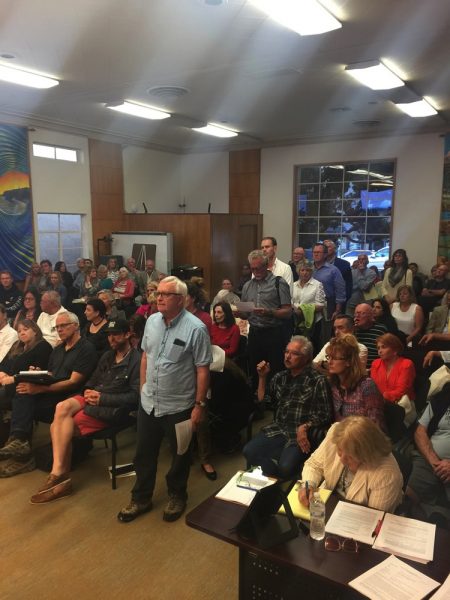By Cassandra Reinhart, Special to the Independent
Members of the Laguna Beach Planning Commission are questioning the benefit of keeping so-called C-rated properties on the city’s 1981 historic inventory, and some questioned keeping the inventory at all.
Debate over new revisions to the city’s historic preservation ordinance stretched over two hours this past Wednesday, April 19, as residents, some in tears, testified in opposition to the proposal.
“The historic inventory was poorly done in 1981, it is not a valid survey,” resident Curt Barwick said. “It creates a presumption that a property is historic.”

The testimony of many residents echoed Barwick’s comments.
Ultimately, commissioners directed city staff to gather more information and options for C-rated structures, clearer communication about its impacts and a second review June 7.
“The lack of certainty is very destructive to people,” said Commissioner Susan Whitin. “It creates a lot of anxiety and you can see it and hear it in people’s voices that it is affecting their health.
“I think we have to take this much more seriously. The structures are what we are supposed to be dealing with here, but structures are inhabited by people, and we need to find a system that is flexible enough, clear enough and incentive-based and at the same time give something back to the city.”
The ordinance revisions call for another evaluation of properties already on the city’s existing 1981 historic inventory, a list classifying homes as “E” or exceptional, “K” for key, or “C” for contributive. Most of the homeowners with “C” classification at the meeting want the right to remove their property from the list, citing higher potential redevelopment costs, restrictions and review hurdles, including approvals from the Heritage Committee and Design Review Board. As proposed, the ordinance will also require all homes undergo review for historical significance when owners seek a permit for remodeling.
“There are very few really great buildings in this town,” said Commissioner Susan Whitin, noting that no more than a dozen qualify for the National Historic Register. “It’s not very many, and we have a vast sea of the ‘C’- rated buildings throughout the city, which really are what contribute to how Laguna feels. The register recognizes and incentivizes the ‘E’ and ‘K’ buildings; the ‘C’ is fraught with murkiness and confusion and uncertainty. People on it find themselves in a purgatory situation that they can’t get out of.”
The California Environmental Quality Act, or CEQA, protects historic resources from demolition or modification. Under the draft ordinance, homes on the historic inventory, including C-rated structures, will need a CEQA determination before being approved by the Design Review Board and can result in only minimal alterations allowed to a property.
Commissioners discussed that while this may be appropriate for historical structures with key architectural features, it can be too restrictive for C-rated homes classified as simply adding character to a neighborhood, and questioned whether C-rated structures should be given more flexibility for development, or even be reclassified altogether to clarify that they are not historic resources but deserve special status during design review. Some even brought into question the validity of the list as a whole.
“It’s like going to a urologist for a foot problem,” said Commissioner Roger McErlane. “I don’t think the Heritage Committee is the proper body to deal with the ‘C’-rated issue at all.”
Commissioner Ken Sadler defended it, saying without the inventory residents will still encounter roadblocks. “We could have no historic inventory, no historic preservation ordinance, then everybody would still have the possibility of having their property determined to be a historic resource anyway,” Sadler said. “By us having a local ordinance, we can create a categorical exemption to that CEQA requirement, so you wouldn’t have that uncertainty of potentially having to do a full blown environmental impact report for a relatively small home remodel.”
A staff report echoed that point. “Doing away with the concept of keeping a current inventory does not mean that certain properties are no longer historic resources,” City Planner Martina Caron said. “Instead, it means the determination will be left for the future when and if they propose to demolish or alter the property.”
“Our options are some flexibility, and still be considered a historic resource, or maximum flexibility and they aren’t considered a historic resource,” Sadler said. “The potential pitfalls of that is that it could make demolition of those ‘C’- rated structures easier.”
Commission Chair Sue Kempf said the obvious public confusion over the ordinance needs to be cleared up before it moves forward.
“We have this thing so convoluted, we are sitting here for three hours trying to sort through this thing because we have got a Laguna Beach overlay of complications,” Kempf said. “I get that we can’t avoid CEQA, but we can craft an ordinance to make it more reasonable for people.”





[…] For the original version including any supplementary images or video, visit http://www.lagunabeachindy.com/planners-step-away-tighter-historic-rules/ […]
[…] was disappointed with the Independent’s misleading title, “Planners Step Away from Tighter Historic Rules,” to describe the Planning Commission’s decision not to approve the proposed changes to the […]
[…] who oppose the historic preservation ordinance say that being identified as historic resources will diminish the value of their homes and make […]